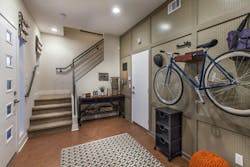Making Way for Bicycles and Pedestrians
In the beginning of the classic 1989 film, Back to the Future: Part II, 17-year-old protagonist Marty McFly travels 30 years into the future to visit his grownup self in the year 2015. Filmmakers effectively prophesied a vivid portrayal of typical American life in, what was at that time, the distant future, complete with flying cars, 3-D holographic movies, self-drying clothes, rapid food hydrators, and the Chicago Cubs finally winning the World Series (against a Miami team that didn't even exist yet). With BTTF’s future becoming today’s present, much has been written about real-life 2015 America verses the futuristic versions depicted on screen. Most of the attention focuses on the lack of flying cars zipping through today’s skies, but the elements that were most captivating were the intimately tactile hoverboards and auto-lacing shoes.
Though skateboards are still bound by gravity, and Nike hasn't released any shoes that spontaneously conform to the contours of our feet, the urban fabric of real-life 2015 will continue to be shaped primarily by the pedestrian and the human-powered vehicle. For decades, the car was king in the development of America’s cities and suburbs, but with the combined force of widespread re-urbanization, economic factors keeping Millennials from conventional job commutes, and overwhelming data linking health to our environment, design for walking and biking should, and will, continue to be the focus.
Green Doesn't Always Mean Foot-Friendly
Unfortunately, most green certification systems still ignore the walkability component of sustainability. While the effectiveness of a building’s sustainable strategies is intrinsically connected to its site, the most important way a building relates to a site is whether or not it's located within walking distance of schools, restaurants, retail, services, and places of employment. Walking safely, conveniently, and efficiently is integral to any good design, and study after study continues to demonstrate the health benefits of walking. It makes sense that communities making a concerted effort to encourage walking via design offer significant health benefits to residents.
Walkable communities are marked by comfortably wide (at least 5 or 6 feet), well-lit sidewalks dotted with canopy street trees, covered by generous building awnings, and connected by protected crosswalks. Walkable communities offer places to sit, with bus stops and connections to other forms of public transportation, clear wayfinding graphics, and adequate receptacles for trash and recycling. Sidewalks need to provide safe pathways for pedestrians.
Walkability Feeds Community
Often the goal of walkability can serve as a catalyst for the design of the community as a whole. At Symphony Apartments, in Costa Mesa, Calif., a generous and welcoming pedestrian plaza became the heart of the project and was designed to replace a utilitarian and unidirectional sidewalk cutting diagonally through an existing surface parking lot. The plaza not only encourages pedestrians to visit the plaza, but it will more easily connect residents of the community to multiple pedestrian paths throughout the South Coast Metro neighborhood for dog-walking, pushing strollers, and recreational running.
Bikeability Is the Future
Communities should also institute safe, convenient, and direct bicycle paths—not just the side of the street separated from automobiles by a thin painted line. Too often, the healthy choice to ride a bicycle involves putting your life at risk. Streets that separate the travel lanes for cars and bicycles with parallel parking, medians, or both, have been used in Denmark for years, and they’re now starting to appear in places like Seattle and downtown Los Angeles.
As today’s denser communities continue to embrace the bicycle as a healthier, cleaner alternative to automobile commuting, those communities need to provide opportunities for that strategy to thrive. Communal space for bike repairs that is stocked with pumps and tools (at my firm, we call it a Bike Kitchen) is a popular and pragmatic amenity, especially in multifamily developments without private garages.
Many cities have already instituted significant bicycle parking requirements within their respective zoning codes. For example, the city of Oakland requires one long-term bicycle space for every four multifamily units, and the city of Los Angeles requires one long-term bicycle space for every single multifamily unit. Those ratios don't even include the additional short-term bike storage that is also required on site. But a bicycle-friendly community won't naturally result from requiring a bunch of bicycle racks in a lockable room. In fact, many of the bicycle requirements aren't producing a bicycle-friendly environment because inflexible storage size and configuration requirements encourage quantity over quality. Besides, most serious cyclists will just keep their bicycles in their units—their bike is too valuable to be banging up against others.
Successful bicycle-friendly communities will take the design of their bike amenities beyond the letter of city zoning ordinances. Rather than push the required bike parking to the deepest corners of the garage, they will consolidate the location of a bicycle storage area with a Bike Kitchen and place the bicycle nodes at significant, convenient spots in the building and within the site as a whole. These bicycle nodes can serve as launching pads for communal cycling groups and provide opportunities to design a landscaped courtyard programmed to support cyclists with outdoor seating, drinking fountains, and shade trees. In addition, some projects, such as RockVue, in Broomfield, Colo., have installed metal diamond plate "bike rails" on the edge of their stair risers to provide a convenient way to lead a bicycle down a flight or two of stairs.
While the dream of piloting our own flying cars is still wildly provocative, that future never seemed quite possible; even the beloved flying time machine (which was built from a DeLorean DMC-12, a model that hadn't been produced commercially since 1983) was already an unattainable dream car in the 1985 setting of the BTTF trilogy. Automobiles will remain a significant aspect of the American culture for the foreseeable future, however, they are reducing in prominence from the collective experience. The cities of today’s present-future will instead be undoubtedly dominated by pedestrians and modern cyclists.
CLICK IMAGE TO VIEW SLIDESHOW
Benjamin Kasdan, AIA and LEED AP, is a senior designer with KTGY Architecture + Planning. He can be reached at 949.851.2133 or [email protected]. (Photos: Teri Fotheringham Photography; Chet Frohlich Photography).


